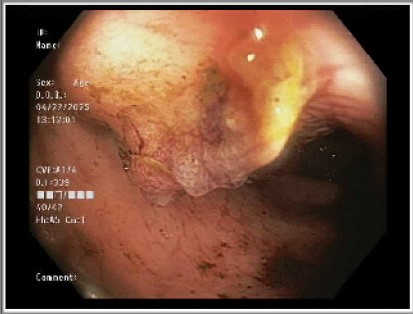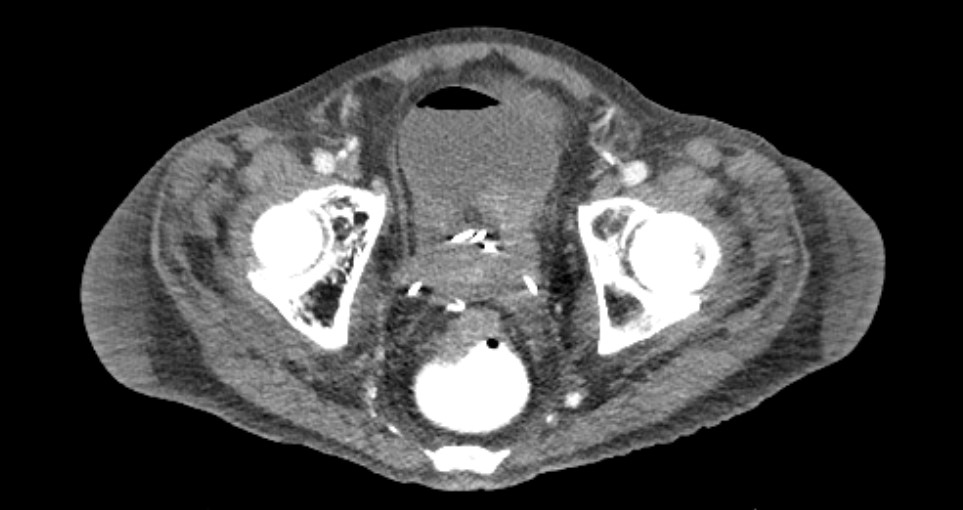Sunday Poster Session
Category: Colon
P0450 - Spindle Cells in the Sigmoid: A Rare Sarcomatoid Transformation of Urothelial Carcinoma
Sunday, October 26, 2025
3:30 PM - 7:00 PM PDT
Location: Exhibit Hall

Ali Rida, MD (he/him/his)
McLaren Greater Lansing Hospital
Dearborn Heights, MI
Presenting Author(s)
Ali Rida, MD1, Taylor Patterson, BS, MS2, Caleb Glover, DO3, Claire C. Russell, DO3, Thomas Barker, MD4, Eric Nguyen, MD3, Edward Cay, DO5, Chintalapudi Kumar, MD3, Dorian Jones, MD4
1McLaren Greater Lansing Hospital, Dearborn Heights, MI; 2Michigan State University College of Osteopathic Medicine, Lansing, MI; 3McLaren Greater Lansing Hospital, Lansing, MI; 4Michigan State University, East Lansing, MI; 5McLaren Greater Lansing, Lansing, MI
Introduction: Sarcomatoid carcinoma of the bladder is an exceptionally rare and aggressive histologic variant of urothelial carcinoma, accounting for less than 0.5% of all bladder tumors [1]. It is defined by the presence of both malignant epithelial and mesenchymal elements, often exhibiting a biphasic morphology. Fewer than 100 cases have been described in the literature [2]. These tumors are notorious for their rapid progression and poor prognosis, with a high propensity for local invasion and distant metastasis, particularly to the peritoneum, lungs, and bone. Despite treatment with systemic multi-agent chemotherapy, the 5-year survival for metastatic urothelial carcinoma remains only ~15%, with median survival often under 12 months [3].
Case Description/
Methods: An 88-year-old man with a past medical history of prostate cancer post-radiation and high-grade urothelial carcinoma presented to the emergency department with hypotension, vomiting, and altered mental status. Initial labs revealed profound hyponatremia (serum sodium 112 mmol/L), prompting ICU admission. Imaging with contrast-enhanced CT showed colonic distension and a mass obstructing the sigmoid colon, raising concern for a primary colorectal malignancy. However, one month prior, colonoscopy performed for hematochezia had identified a 5 cm obstructing sigmoid mass. Biopsy demonstrated high-grade carcinoma with sarcomatoid differentiation. Immunohistochemistry was positive for GATA3 and CK7, favoring a urothelial over a prostatic origin. Given the extensive disease, inoperability, and overall frailty, colorectal surgery and oncology jointly recommended against surgical or chemotherapeutic intervention. The patient and family elected for hospice, and he was discharged with a comfort-focused plan.
Discussion: This case illustrates an unusual presentation of sarcomatoid urothelial carcinoma mimicking primary colorectal cancer due to direct invasion of the sigmoid colon. Sarcomatoid transformation is linked with highly aggressive behavior and poor response to therapy [1,2]. The tumor’s dual histology can complicate diagnosis and delay appropriate management. Early involvement of a multidisciplinary team is crucial for prognosis assessment and for facilitating patient-centered goals of care. Palliative care should be integrated early when curative options are no longer viable [3].

Figure: CT Abdomen demonstrating concerning neoplasm in the sigmoid colon

Figure: Colonoscopy imaging demonstrating 5 x 5 cm sized mass in the sigmoid colon.
Disclosures:
Ali Rida indicated no relevant financial relationships.
Taylor Patterson indicated no relevant financial relationships.
Caleb Glover indicated no relevant financial relationships.
Claire Russell indicated no relevant financial relationships.
Thomas Barker indicated no relevant financial relationships.
Eric Nguyen indicated no relevant financial relationships.
Edward Cay indicated no relevant financial relationships.
Chintalapudi Kumar indicated no relevant financial relationships.
Dorian Jones indicated no relevant financial relationships.
Ali Rida, MD1, Taylor Patterson, BS, MS2, Caleb Glover, DO3, Claire C. Russell, DO3, Thomas Barker, MD4, Eric Nguyen, MD3, Edward Cay, DO5, Chintalapudi Kumar, MD3, Dorian Jones, MD4. P0450 - Spindle Cells in the Sigmoid: A Rare Sarcomatoid Transformation of Urothelial Carcinoma, ACG 2025 Annual Scientific Meeting Abstracts. Phoenix, AZ: American College of Gastroenterology.
1McLaren Greater Lansing Hospital, Dearborn Heights, MI; 2Michigan State University College of Osteopathic Medicine, Lansing, MI; 3McLaren Greater Lansing Hospital, Lansing, MI; 4Michigan State University, East Lansing, MI; 5McLaren Greater Lansing, Lansing, MI
Introduction: Sarcomatoid carcinoma of the bladder is an exceptionally rare and aggressive histologic variant of urothelial carcinoma, accounting for less than 0.5% of all bladder tumors [1]. It is defined by the presence of both malignant epithelial and mesenchymal elements, often exhibiting a biphasic morphology. Fewer than 100 cases have been described in the literature [2]. These tumors are notorious for their rapid progression and poor prognosis, with a high propensity for local invasion and distant metastasis, particularly to the peritoneum, lungs, and bone. Despite treatment with systemic multi-agent chemotherapy, the 5-year survival for metastatic urothelial carcinoma remains only ~15%, with median survival often under 12 months [3].
Case Description/
Methods: An 88-year-old man with a past medical history of prostate cancer post-radiation and high-grade urothelial carcinoma presented to the emergency department with hypotension, vomiting, and altered mental status. Initial labs revealed profound hyponatremia (serum sodium 112 mmol/L), prompting ICU admission. Imaging with contrast-enhanced CT showed colonic distension and a mass obstructing the sigmoid colon, raising concern for a primary colorectal malignancy. However, one month prior, colonoscopy performed for hematochezia had identified a 5 cm obstructing sigmoid mass. Biopsy demonstrated high-grade carcinoma with sarcomatoid differentiation. Immunohistochemistry was positive for GATA3 and CK7, favoring a urothelial over a prostatic origin. Given the extensive disease, inoperability, and overall frailty, colorectal surgery and oncology jointly recommended against surgical or chemotherapeutic intervention. The patient and family elected for hospice, and he was discharged with a comfort-focused plan.
Discussion: This case illustrates an unusual presentation of sarcomatoid urothelial carcinoma mimicking primary colorectal cancer due to direct invasion of the sigmoid colon. Sarcomatoid transformation is linked with highly aggressive behavior and poor response to therapy [1,2]. The tumor’s dual histology can complicate diagnosis and delay appropriate management. Early involvement of a multidisciplinary team is crucial for prognosis assessment and for facilitating patient-centered goals of care. Palliative care should be integrated early when curative options are no longer viable [3].

Figure: CT Abdomen demonstrating concerning neoplasm in the sigmoid colon

Figure: Colonoscopy imaging demonstrating 5 x 5 cm sized mass in the sigmoid colon.
Disclosures:
Ali Rida indicated no relevant financial relationships.
Taylor Patterson indicated no relevant financial relationships.
Caleb Glover indicated no relevant financial relationships.
Claire Russell indicated no relevant financial relationships.
Thomas Barker indicated no relevant financial relationships.
Eric Nguyen indicated no relevant financial relationships.
Edward Cay indicated no relevant financial relationships.
Chintalapudi Kumar indicated no relevant financial relationships.
Dorian Jones indicated no relevant financial relationships.
Ali Rida, MD1, Taylor Patterson, BS, MS2, Caleb Glover, DO3, Claire C. Russell, DO3, Thomas Barker, MD4, Eric Nguyen, MD3, Edward Cay, DO5, Chintalapudi Kumar, MD3, Dorian Jones, MD4. P0450 - Spindle Cells in the Sigmoid: A Rare Sarcomatoid Transformation of Urothelial Carcinoma, ACG 2025 Annual Scientific Meeting Abstracts. Phoenix, AZ: American College of Gastroenterology.
